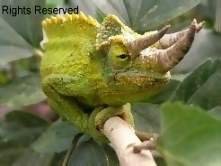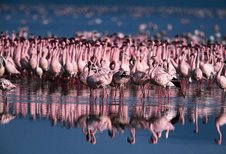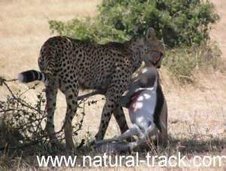It is now official that the number of one of the world’s most
charismatic and endangered species is out and its good news to the world
today especially the enthusiastic conservationists. This is according
to the partial report posted by the African Wildlife Foundation in
Kigali, Rwanda.
The analysis of the census conducted in last year indicates that there were a total of 480 mountain gorillas, (Gorilla beringei beringei), in 36 groups along with 14 solitary silverback males in the Virunga Massif.
Along with the 302 mountain gorillas censured in Bwindi in 2006 and
four orphaned mountain gorillas in a sanctuary in DRC, this brings the
new total world population to 786 individuals. The last census
undertaken in the Virunga Massif was in 2003, when the population was
estimated at 380 individuals.
The current figure represents a 26.3 % increase in the population of
mountain gorillas in this area over the last seven years, which is a 3.7
% annual growth rate. This increase in the population occurred despite
the killing of no less than nine mountain gorillas, in four separate
incidents, during this time period.
Of the 480 mountain gorillas censured, 352 (73%) were habituated (349
in groups and three solitary males) and 128 were unhabituated (117 in
groups and 11 solitary males).
Virunga massif includes three contiguous national parks namely; Parc
National des Virunga in DRC, Volcanoes National Park in Rwanda and
Mgahinga Gorilla National Park in Uganda. The only other location where
mountain gorillas exist is Bwindi Impenetrable National Park in Uganda.
The goal of the census was not only to assess the population level of
the mountain gorillas, but their level of health as well. Analyses
conducted on fecal samples will contribute to one of the most
comprehensive health screenings of any wild ape population.
The results will also be extremely valuable in order to make
comparisons between populations, and between habituated and unhabituated
groups. These results will not only serve as a baseline for
understanding the health status of the mountain gorillas, but may also
provide insights into past and future exposure to human pathogens.
The census itself was an exercise in collaboration, and IGCP played a
lead role in attracting support for the census and coordinating all
participating institutions and organizations. Over 1,000 kilometers were
systematically walked by six mixed teams of seventy-two people from
DRC, Rwanda, and Uganda.
Teams covered the entire range and meticulously documented fresh
signs of mountain gorilla groups. Genetic analysis of fecal samples
collected was analyzed to identify and correct for any double-counting
of individuals or groups, ensuring the most accurate estimate for the
population.
Although habituated mountain gorillas are continuously monitored,
periodic census of the population is a necessary step in conservation.
The census not only recorded the presence of mountain gorillas, but also
the presence of other large mammals and illegal activities like bamboo
cutting and snares.
While the incredible increase in this population of mountain gorillas
is clearly a good thing and cause for celebration, the threats to their
existence are persistent. Recently, a coordinated patrol discovered and
destroyed just over 200 snares in the Virunga Massif over a five-day
patrol. Although poachers typically do not target mountain gorillas, the
snares they set are a threat nonetheless.
The Virunga Massif mountain gorilla census was conducted by the
protected area authorities in the three countries: L’Institut Congolais
pour la Conservation de la Nature, the Rwanda Development Board and the
Uganda Wildlife Authority.
The census was supported by the International Gorilla Conservation
Programme (a coalition of the African Wildlife Foundation, World Wide
Fund for Nature, and Fauna & Flora International), the Max Planck
Institute for Evolutionary Anthropology, the Dian Fossey Gorilla Fund –
International and the Mountain Gorilla Veterinary Project.
The census was funded by WWF-Sweden, Fair Play Foundation, and the
Netherlands Directorate General for International Cooperation (DGIS)
through the Greater Virunga Transboundary Collaboration.
The full report of the census, which will be available in 2011, will
include details on population dynamics and distribution of the Virunga
gorilla population as well as population structure and genetic
composition. These details will provide a scientific basis from which
IGCP and other conservation institutions and organizations will plan
collective conservation efforts.
PKP-Kenya Safari desk
Natural Track Safaris
Subscribe to:
Post Comments (Atom)









No comments:
Post a Comment